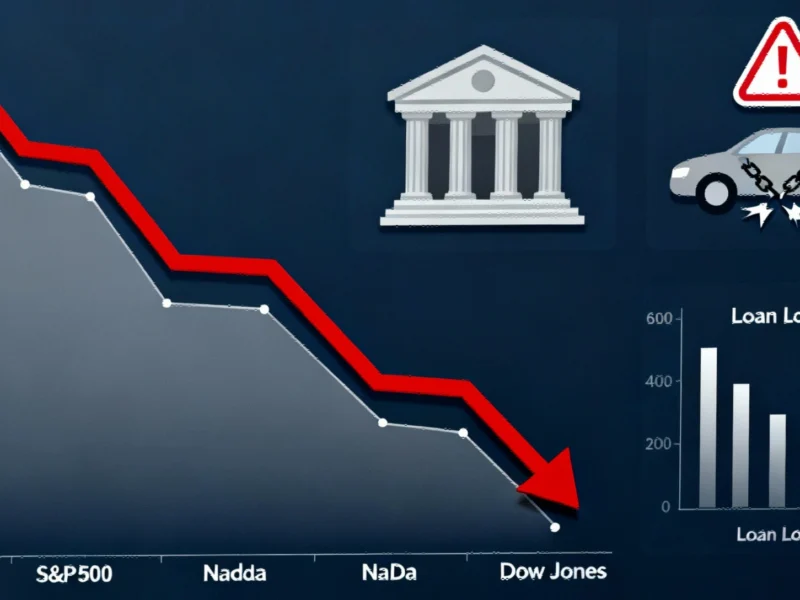The Data-Driven Lens on Economic Health
While recent bank stock volatility has captured headlines, the real story lies in how financial institutions are leveraging advanced computing systems to interpret economic signals. Banks are increasingly relying on sophisticated industrial computing platforms to process massive datasets that reveal underlying economic trends. This technological approach goes far beyond traditional indicators, providing a more nuanced understanding of potential trouble spots.
Credit Quality Monitoring Through Advanced Analytics
The growing concerns around credit quality have pushed banks to deploy increasingly sophisticated monitoring systems. Financial institutions are now using machine learning algorithms running on high-performance computing infrastructure to analyze patterns across millions of loan applications, payment histories, and borrower behaviors. These systems can detect subtle shifts in creditworthiness long before traditional methods would raise alarms, allowing for proactive risk management strategies.
As noted in recent banking sector analysis, institutions are particularly focused on cross-referencing credit data with external economic factors. This comprehensive approach helps identify correlations that might otherwise remain hidden in isolated datasets.
Sector-Specific Weakness Detection
Banking analysts are paying close attention to several key sectors showing signs of strain. The auto-financing business has demonstrated particular softness, with computing systems flagging unusual patterns in loan delinquencies and vehicle repossession rates. Similarly, home construction data continues to show sluggishness, with industrial computing platforms tracking everything from building permit applications to construction material purchasing patterns.
These sector-specific analyses benefit greatly from external IT partnerships that provide specialized computing resources and analytical expertise. Such collaborations enable banks to process complex sector data without maintaining expensive specialized infrastructure internally.
Tariff Impact Assessment
The ongoing evaluation of tariff impacts represents another area where computing power proves crucial. Banks are running complex simulation models to understand how various tariff scenarios affect client costs across different industries. These models incorporate thousands of variables, from supply chain dependencies to consumer price elasticity, requiring substantial computational resources.
Recent trade developments have highlighted the importance of these forecasting capabilities. Banking systems must rapidly recalibrate their models as diplomatic situations evolve, demonstrating the critical role of flexible, powerful computing infrastructure in modern economic analysis.
Emerging Data Sources and Compliance Considerations
Beyond traditional economic indicators, banks are exploring unconventional data sources. The growing significance of digital assets has prompted increased scrutiny of cryptocurrency markets, with institutions monitoring blockchain transactions and wallet activities for economic signals. This expansion into new data territories brings additional compliance considerations, particularly as regulatory bodies increase their focus on this emerging asset class.
The recent enforcement actions by tax authorities underscore the importance of robust computing systems capable of tracking and reporting these complex financial interactions. Banks must balance their analytical needs with evolving regulatory requirements across multiple jurisdictions.
Technological Infrastructure Requirements
The shift toward data-intensive economic forecasting demands significant upgrades to banking technology infrastructure. Institutions are investing in high-performance computing clusters, specialized analytics software, and secure data storage solutions. These systems must process real-time data streams while maintaining the security and reliability expected in the financial sector.
Some institutions are exploring web-based platforms and mobile solutions to distribute economic insights throughout their organizations. The ability to access complex economic analyses on multiple devices has become increasingly important for decision-makers who need current information regardless of their location.
Integration with Broader Industry Trends
Banking economic analysis doesn’t exist in isolation—it increasingly intersects with broader technological and entertainment trends. The growing convergence between financial services and other industries creates both challenges and opportunities for economic forecasters.
Recent entertainment industry movements and parallel technology developments demonstrate how consumer behavior patterns across different sectors can provide valuable economic insights. Banks monitoring these market trends gain a more comprehensive understanding of consumer confidence and spending patterns.
Future Outlook and Strategic Implications
As economic uncertainty persists, the role of industrial computing in banking analysis will only expand. Institutions that successfully leverage these technologies will maintain a significant advantage in identifying emerging risks and opportunities. The continuous evolution of related innovations in computing power and analytical methodologies suggests that economic forecasting will become increasingly precise and comprehensive.
Banking leaders recognize that their ability to navigate economic challenges depends heavily on their technological infrastructure and analytical capabilities. Investment in these areas represents not just a competitive advantage but a fundamental requirement for sustainable operations in an increasingly complex global economy.
This article aggregates information from publicly available sources. All trademarks and copyrights belong to their respective owners.
Note: Featured image is for illustrative purposes only and does not represent any specific product, service, or entity mentioned in this article.



